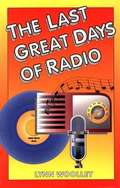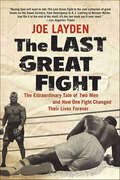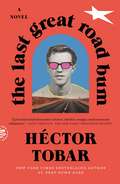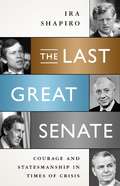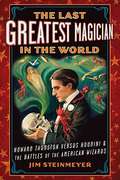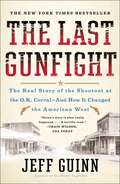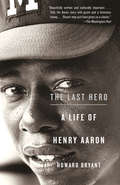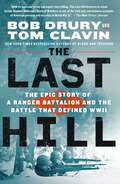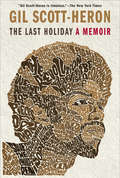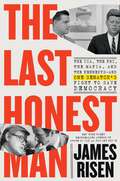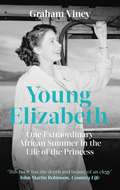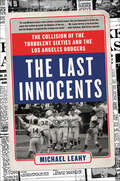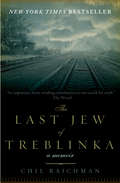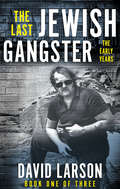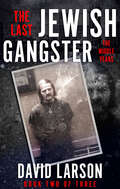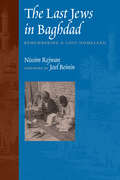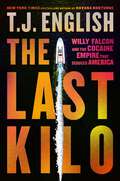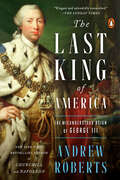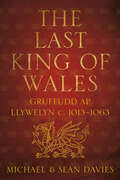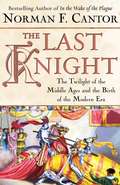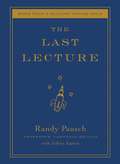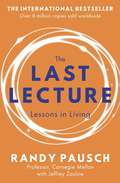- Table View
- List View
The Last Great Days of Radio
by Lynn WoolleyIf you've ever wanted to be in radio--or ever wondered what was happening on the other side of the dial, then this book is for you. You'll find out what it's like to get that first job, to work in Texas's largest newsroom, to cover a major murder trial, to cover the President of the United States, to follow the Dallas Cowboys to the Super Bowl, and to create top-rated comedy routines. Full of inside information about the radio business, this book touches on the careers of dozens of well-known broadcasters. Long time radio personality Lynn Woolley introduces you to the laughs and times of Texas radio in its heyday. A mixture of humor, wit, and nostalgia, this book follows the career of Woolley from the smallest station in a small market to the largest radio newsroom in Texas, and back again.
The Last Great Fight: The Extraordinary Tale of Two Men and How One Fight Changed Their Lives Forever
by Joe LaydenMeticulously researched, wonderfully written; The Last Great Fight tells the untold story of a legendary fight and the two warriors who would never be the same againIt is considered by many to be the biggest upset in the history of boxing: James "Buster" Douglas knocked out then-undefeated Heavyweight Champion Mike Tyson in the 10th round in 1990 when the dominating and intimidating Tyson was considered invincible.The Last Great Fight takes readers not only behind the scenes of this epic battle, but inside the lives of two men, their ambitions, their dreams, the downfall of one and the rise of another.Using his exclusive interviews with both boxers Tyson and Douglas, family members, the referee, the cutmen, trainers and managers to the commentators and HBO staff covering the fight in Tokyo, Joe Layden has crafted a human drama played out on a large stage. This is a compelling tale of shattered dreams and, ultimately, redemption.
The Last Great Road Bum: A Novel
by Héctor TobarOne of the Los Angeles Times Top 10 California Books of 2020. One of Publishers Weekly’s Top 10 Fiction Books from 2020. Longlisted for the Carnegie Medal for Excellence and the Joyce Carol Oates prize. One of Exile in Bookville’s Favorite Books of 2020. In The Last Great Road Bum, Héctor Tobar turns the peripatetic true story of a naive son of Urbana, Illinois, who died fighting with guerrillas in El Salvador into the great American novel for our times.Joe Sanderson died in pursuit of a life worth writing about. He was, in his words, a “road bum,” an adventurer and a storyteller, belonging to no place, people, or set of ideas. He was born into a childhood of middle-class contentment in Urbana, Illinois and died fighting with guerillas in Central America. With these facts, acclaimed novelist and journalist Héctor Tobar set out to write what would become The Last Great Road Bum.A decade ago, Tobar came into possession of the personal writings of the late Joe Sanderson, which chart Sanderson’s freewheeling course across the known world, from Illinois to Jamaica, to Vietnam, to Nigeria, to El Salvador—a life determinedly an adventure, ending in unlikely, anonymous heroism.The Last Great Road Bum is the great American novel Joe Sanderson never could have written, but did truly live—a fascinating, timely hybrid of fiction and nonfiction that only a master of both like Héctor Tobar could pull off.
The Last Great Senate
by Ira ShapiroJournalists have called the U.S. Senate an empty chamber; politicians have lamented that the institution is broken-yet the Senate was once capable of greatness. Senators of the 1960s and '70s overcame southern opposition to civil rights, passed Great Society legislation, and battled the executive branch on Vietnam, Watergate, and its abuses of power. The right's sweep of the 1980 elections shattered that Senate, leaving a diminished institution in its wake. Ira Shapiro spent 12 years working for Senators Gaylord Nelson, Abraham Ribicoff, Thomas Eagleton, Robert Byrd, and Jay Rockefeller. The Last Great Senate is his vivid portrait of the statesmen who helped steer America during the crisis years of the late 1970s, transcending partisanship and overcoming procedural roadblocks that have all but strangled the Senate since their departure. The Last Great Senate is necessary reading for all those who wonder how the Senate used to work and what happened to the world's greatest deliberative body.
The Last Great Senate: Courage and Statesmanship in Times of Crisis
by Ira Shapiro"The Last Great Senate" is Shapiro's vivid portrait of the statesmen who helped steer America during the crisis years of the late 1970s, transcending partisanship and overcoming procedural roadblocks that have all but strangled the Senate since their departure.
The Last Greatest Magician in the World: Howard Thurston Versus Houdini & the Battles of the American Wizards
by Jim SteinmeyerHere is the seminal biography of the magician's magician, Howard Thurston, a man who surpassed Houdini in the eyes of showmen and fans and set the standard fro how stage magic is performed today. Everyone knows Houdini-but who was Thurston? In this rich, vivid biography of the "greatest magician in the world," celebrated historian of stage magic Jim Steinmeyer captures the career and controversies of the wonder-worker extraordinaire, Howard Thurston. The public's fickleness over magicians has left Thurston all but forgotten today. Yet Steinmeyer shows how his story is one of the most remarkable in show business. During his life, from 1869 to 1936, Thurston successfully navigated the most dramatic changes in entertainment-from street performances to sideshows to wagon tours through America's still-wild West to stage magic amid the glitter of grand theaters. Thurston became one of America's most renowned vaudeville stars, boldly performing an act with just a handful of playing cards, and then had the foresight to leave vaudeville, expanding his show into an extravaganza with more than forty tons of apparatusand costumes. His touring production was an American institution for nearly thirty years, and Thurston earned a brand name equal to Ziegfeld or Ringling Brothers. Steinmeyer explores the stage and psychological rivalry between Thurston and Houdini during the first decades of the twentieth century- a contest that Thurston won. He won with a bigger show, a more successful reputation, and the title of America's greatest magician. In The Last Greatest Magician in the World, Thurston's magic show is revealed as the one that animates our collective memories.
The Last Gunfight: The Real Story of the Shootout at the O.K. Corral-And How It Changed the American West
by Jeff GuinnA New York Times bestseller, Jeff Guinn&’s definitive, myth-busting account of the most famous gunfight in American history reveals who Wyatt Earp, Doc Holliday, and the Clantons and McLaurys really were and what the shootout was all about—&“the most thorough account of the gunfight and its circumstances ever published&” (The Wall Street Journal)On the afternoon of October 26, 1881, in a vacant lot in Tombstone, Arizona, a confrontation between eight armed men erupted in a deadly shootout. The Gunfight at the O.K. Corral would shape how future generations came to view the Old West. Wyatt Earp, Doc Holliday, and the Clantons became the stuff of legends, symbolic of a frontier populated by good guys in white hats and villains in black ones. It’s a colorful story—but the truth is even better. Drawing on new material from private collections—including diaries, letters, and Wyatt Earp’s own hand-drawn sketch of the shootout’s conclusion—as well as archival research, Jeff Guinn gives us a startlingly different and far more fascinating picture of what actually happened that day in Tombstone and why.
The Last Hero: A Life of Henry Aaron
by Howard BryantIn the thirty-four years since his retirement, Henry Aaron's reputation has only grown in magnitude: he broke existing records (RBIs, total bases, extra-base hits) and set new ones (hitting at least thirty home runs per season fifteen times, becoming the first player in history to hammer five hundred home runs and three thousand hits). But his influence extends beyond statistics, and at long last here is the first definitive biography of one of baseball's immortal figures. Based on meticulous research and interviews with former teammates, family, two former presidents, and Aaron himself, The Last Hero chronicles Aaron's childhood in segregated Alabama, his brief stardom in the Negro Leagues, his complicated relationship with celebrity, and his historic rivalry with Willie Mays--all culminating in the defining event of his life: his shattering of Babe Ruth's all-time home-run record. Bryant also examines Aaron's more complex second act: his quest to become an important voice beyond the ball field when his playing days had ended, his rediscovery by a public disillusioned with today's tainted heroes, and his disappointment that his career home-run record was finally broken by Barry Bonds during the steroid era, baseball's greatest scandal. Bryant reveals how Aaron navigated the upheavals of his time--fighting against racism while at the same time benefiting from racial progress--and how he achieved his goal of continuing Jackie Robinson's mission to obtain full equality for African-Americans, both in baseball and society, while he lived uncomfortably in the public spotlight. Eloquently written, detailed and penetrating, this is a revelatory portrait of a complicated, private man who through sports became an enduring American icon.
The Last Hill: The Epic Story of a Ranger Battalion and the Battle That Defined WWII
by Bob Drury Tom ClavinBob Drury and Tom Clavin's The Last Hill is the incredible untold story of one Ranger battalion's heroism and courage in World War II.They were known as “Rudder’s Rangers,” the most elite and experienced attack unit in the United States Army. In December 1944, Lt. Col. James Rudder's 2nd Battalion would form the spearhead into Germany, taking the war into Hitler’s homeland at last. In the process, Rudder was given two objectives: Take Hill 400 . . . and hold the hill by any means possible. To the last man, if necessary. The battle-hardened battalion had no idea that several Wehrmacht regiments, who greatly outnumbered the Rangers, had been given the exact same orders. The clash of the two determined forces was one of the bloodiest and most costly encounters of World War II.Castle Hill, the imposing 1320-foot mini-mountain the American Rangers simply called Hill 400, was the gateway to a desperate Nazi Germany. Several entire American divisions had already been repulsed by the last hill's dug-in defenders as—unknown to the Allies—the height was the key to Adolf Hitler's last-minute plans for a massive counterattack to smash through the American lines in what would become known to history as the Battle of the Bulge.Thus the stalemate surrounding Hill 400 could not continue. For Supreme Allied Commander Gen. Dwight Eisenhower, there was only one solution: Call in Rudder's Rangers. Of the 130 special operators who stormed, captured, and held the hill that December day, only 16 remained to stagger back down its frozen slopes. The Last Hill is replete with unforgettable action and characters—a rich and detailed saga of what the survivors of the 2nd Ranger Battalion would remember as “our longest day.”
The Last Hindu Emperor
by Cynthia TalbotThis fascinating new study traces traditions and memories relating to the twelfth-century Indian ruler Prithviraj Chauhan; a Hindu king who was defeated and overthrown during the conquest of Northern India by Muslim armies from Afghanistan. Surveying a wealth of narratives that span more than 800 years, Cynthia Talbot explores the reasons why he is remembered, and by whom. In modern times, the Chauhan king has been referred to as 'the last Hindu emperor', because Muslim rule prevailed for centuries following his defeat. Despite being overthrown, however, his name and story have evolved over time into a historical symbol of India's martial valor. The Last Hindu Emperor sheds new light on the enduring importance of heroic histories in Indian culture and the extraordinary ability of historical memory to transform the hero of a clan into the hero of a community, and finally a nation.
The Last Holiday: A Memoir (Canons #61)
by Gil Scott HeronThe stunning memoir of Grammy Lifetime Achievement Award winner Gil Scott-Heron, The Last Holiday has been praised for bringing back to life one of the most important voices of the last fifty years. Now in paperback, The Last Holiday provides a remarkable glimpse into Scott-Heron's life and times, from his humble beginnings to becoming one of the most influential artists of his generation.The memoir climaxes with a historic concert tour in which Scott-Heron's band opened for Stevie Wonder. The Hotter than July tour traveled cross-country from late 1980 through early 1981, drumming up popular support for the creation of Martin Luther King Jr. Day. King's birthday, January 15, was marked with a massive rally in Washington.A fitting testament to the achievements of an extraordinary man, The Last Holiday provides a moving portrait of Scott-Heron's relationship with his mother, personal recollections of Stevie Wonder, Bob Marley, John Lennon, Michael Jackson, Clive Davis, and other musical figures, and a compelling narrative vehicle for Scott-Heron's insights into the music industry, the civil rights movement, governmental hypocrisy, and our wider place in the world. The Last Holiday confirms Scott-Heron as a fearless truth-teller, a powerful artist, and an inspiring observer of his times.
The Last Honest Man: The CIA, the FBI, the Mafia, and the Kennedys—and One Senator's Fight to Save Democracy
by James RisenIn this &“gripping . . . spectacular piece of reporting&” (Ken Burns), a Pulitzer Prize-winning journalist examines Senator Frank Church, the man at the center of numerous investigations into the abuses of power within the American government. For decades now, America&’s national security state has grown ever bigger, ever more secretive and powerful, and ever more abusive. Only once did someone manage to put a stop to any of it. Senator Frank Church of Idaho was an unlikely hero. He led congressional opposition to the Vietnam War and had become a scathing, radical critic of what he saw as American imperialism around the world. But he was still politically ambitious, privately yearning for acceptance from the foreign policy establishment that he hated and eager to run for president. Despite his flaws, Church would show historic strength in his greatest moment, when in the wake of Watergate he was suddenly tasked with investigating abuses of power in the intelligence community. The dark truths that Church exposed—from assassination plots by the CIA, to links between the Kennedy dynasty and the mafia, to the surveillance of civil rights activists by the NSA and FBI—would shake the nation to its core, and forever change the way that Americans thought about not only their government but also their ability to hold it accountable. Drawing upon hundreds of interviews, thousands of pages of recently declassified documents, and reams of unpublished letters, notes, and memoirs, some of which remain sensitive today, Pulitzer Prize–winning reporter James Risen tells the gripping, untold story of truth and integrity standing against unchecked power—and winning—in The Last Honest Man. An instant New York Times bestseller
The Last Hurrah: The 1947 Royal Tour of Southern Africa and the End of Empire
by Graham VineyYoung Elizabeth captures in vivid detail perhaps the single-most important formative experience in Queen Elizabeth's life, the 1947 royal tour of southern Africa with her parents King George VI, Queen Elizabeth and Princess Margaret, during which she celebrated her twenty-first birthday.The year of the royal tour of southern Africa, 1947, marked both the high-water mark of the British Empire and the very moment at which it began to unravel. Graham Viney has written an intimate, revealing portrait of the young princess on tour with her parents and sister, Princess Margaret, hard at work in the national interest, and succeeding triumphantly against all odds. In the words of Rian Malan, South African author of My Traitor's Heart, it is 'a story about a country teetering on the brink of convulsive change and yet almost united, at least for a moment, by love for a king and queen who weren't really ours.' The year 1947 was a pivotal moment not just in the history of the Union of South Africa, but of the British Empire itself. Later that same year India gained independence and just one year later the Afrikaner Nationalist victory in South Africa would lead inexorably to the Republic of South Africa in 1961 and its departure from the Commonwealth. The present Queen Elizabeth must have learned a great deal about statecraft from her father, and about duty, tact and hard work from both her parents in the course of this three-month tour, during which the then princess celebrated her twenty-first birthday. It was also the family's first real experience of multiculturalism. Graham Viney's book gives us an intimate and revealing portrait of the royal family, while also superbly capturing a moment in the life of a fractious, recently formed 'nation', before its descent into over four decades of darkness. The royal family travelled ceaselessly, from February to April, on a specially commissioned, white-and-gold train, meeting thousands of people at every stop along the way. The tour was a show of imperial solidarity and a recognition of South Africa's contribution to the Allied cause during the Second World War, specifically that of South African prime minister Jan Smuts, who had served in both British war cabinets.Young Elizabeth draws skilfully on many diverse sources, not least the Royal Archive at Windsor, and includes many photographs of the royal family not previously published, such as stills from film footage held by the South African National Film, Video and Sound Archives in Pretoria.
The Last Impresario
by Michael WhiteThe Last Impresario--the most famous person you've never heard of--is now the subject of a major motion picture, directed by Gracie Otto. Michael White is one of the most inspirational producers of our time, responsible for changing the face of Britain's cultural scene in the 1970s. White has been involved in an amazingly wide range of shows, many of them hits, some of them disastrous failures, all of them unusual. His career encompasses the plays of Athol Fugard, Joe Orton's Loot, Oh! Calcutta!, the catastrophic Jeeves, the money-spinning Sleuth, The Threepenny Opera, starring Vanessa Redgrave, The Rocky Horror Show, and movies ranging from My Dinner with Andre to Monty Python cannot, by the wildest stretch of the imagination, be dubbed conventional. In this autobiography, originally published as Empty Seats in 1984, Michael White tells many marvelous stories and asks some wonderful questions. Why did Orson Welles make a one-armed Peter Daubeny carry his suitcases? What really happened during a performance of The Dirtiest Show in Town? What did Peter Sellers do to Spike Milligan's roast chicken? What were Kenneth Tynan, Joe Orton, and Dame Edna Everage really like? The reader discovers how a play is put on, what kind of money is involved, what techniques are used. "You, too," White seems to say, "can be a producer. And this is how you set about it." Drawing on all too many experiences he might prefer to forget, White would no doubt add, "And that way madness lies."
The Last Innocents: The Collision of the Turbulent Sixties and the Los Angeles Dodgers
by Michael LeahyCasey Award Winner: “Follows seven Dodgers, including Sandy Koufax, through the 1960s, telling a story about baseball and about larger cultural changes.” —The New York Times Book ReviewWinner, Casey Award for Best Baseball Book of the YearFinalist, PEN/ESPN Award for Literary Sports WritingMaury Wills, Sandy Koufax, Wes Parker, Jeff Torborg, Dick Tracewski, and Tommy Davis encapsulated 1960s America: white and black, Jewish and Christian, wealthy and working class, pro-Vietnam and anti-war, golden boy and seasoned veteran. The Last Innocents is a thoughtful, technicolor portrait of these seven Los Angeles Dodgers—friends, mentors, confidants, rivals, and allies—and their storied team that offers an intriguing look at a sport and a nation in transition. Bringing into focus the high drama of their World Series appearances from 1962 to 1972 and their pivotal games, Michael Leahy explores these men’s interpersonal relationships and illuminates the triumphs, agonies, and challenges each faced individually and as a team.Increasingly frustrated over a lack of real bargaining power and an oppressive management who meddled in their personal affairs, the players shared an uneasy relationship with the team’s front office. This contention mirrored the discord and uncertainty generated by changes rocking the nation: the civil rights movement, political assassinations, and growing hostility to the escalation of the Vietnam War. While the nation around them changed, these players each experienced a personal and professional metamorphosis that would alter public perceptions and their own. Comprehensive and artfully crafted, The Last Innocents is an evocative and riveting portrait of a pivotal era in baseball and modern America“A great American story.” —David Maraniss, Pulitzer Prize–winning and New York Times–bestselling author of Clemente“A gripping narrative.” —Publishers Weekly
The Last Jew of Treblinka: A Memoir
by Chil Rajchman<P>Quickly becoming a cornerstone of Holocaust historiography--a devastatingly stark memoir from one of the lone survivors of Treblinka <P>Why do some live while so many others perish? Tiny children, old men, beautiful girls. In the gas chambers of Treblinka, all are equal. The Nazis kept the fires of Treblinka burning night and day, a central cog in the wheel of the Final Solution. In the tradition of Elie Wiesel's Night and Primo Levi's Survival at Auschwitz and The Drowned and the Saved, Rajchman provides the only survivors' record of Treblinka. <P>Originally written in Yiddish in 1945 without hope or agenda other than to bear witness, Rajchman's tale shows that sometimes the bravest and most painful act of all is to remember. <P><b>A New York Times Bestseller</b>
The Last Jewish Gangster: The Early Years
by David Larson“A captivating and different kind of story” about the life of Bugsy Siegel’s godson, from the author “who captured his voice” (Nick Pileggi, author/screenwriter of Goodfellas and Casino).In 1944 Brooklyn, newborn Michael J. Hardy is rejected by his mother so she can run with gangster Bugsy Siegel, Hardy’s godfather. Shirley Rook rose to the top of the criminal ranks. As the Queen of New York City crime, she laundered Mob money, ran the city’s largest bookmaking operation, and handed payouts to dirty cops, politicians, and judges.To win his mother’s love and respect, Hardy became a fearless gangster. Throughout his career as a mercenary, he robbed banks and drug dealers alike, ran a kidnapping ring, and even became a hired gun. At his lowest, he ended up doing time for his mother’s counterfeiting operation in Mexico’s most dangerous prison.Hardy’s criminal code of conduct combines elements of tough Ukrainian Jew and warm Southern Baptist, whether dealing with family and friends or fellow inmates during a combined twenty-six years spent in prisons and jails. He maintained this characteristic gregarious strength throughout his astonishing life in which Hardy was shot eleven times, committed fourteen hits for the Mob, twice wore wires for Rudy Giuliani to nab dirty cops, wrote a letter to JFK to get out of military prison, choked the Hillside Strangler, shared prison time with notorious criminals, and even spent ten years in Hollywood, cast in non-speaking roles in B-movies.“A fascinating character study of an unapologetic criminal. David S. Larson masterfully weaves this tale in Michael Hardy’s own words, resulting in a powerful, inside story of a gangster’s life.” —Cathy Scott, Los Angeles Times-bestselling author
The Last Jewish Gangster: The Middle Years
by David LarsonThe second installment of this saga of gangland lore follows gregarious gangster, Michael Hardy, further down his twisted criminal path. The Last Jewish Gangster, The Middle Years, starts in 1968 with Hardy sentenced to twelve years in the world&’s most dangerous prison in Mexico after taking the rap for his mother&’s counterfeiting scheme, hoping to have finally earned her love and respect. Once he&’s released from prison, Hardy returns to Brooklyn and tries to go straight, but drifts back into a world of crime. He gets Sammy &“the Bull&” Gravano to join his crew to pull major heists like kidnapping drug lords for million-dollar ransoms, and robbing cop bag men. To evade the law, he goes to Europe and ends up in Israel where he works on a Kibbutz, touching the hem of his Jewish heritage. Hardy devolves further into a gangster&’s life when he returns to Brooklyn, running a finger of the Mob&’s Five-Fingers International Car Theft Ring, participating in a stolen airline ticket scam, and doing fourteen hits for the Mob, still hoping his mother will take notice. When she gets busted for the car theft ring, she turns him in to reduce her time. Crushed by his mother&’s callous self-interest, Hardy ends up cutting a deal with Rudy Giuliani to nab a dirty cop to reduce his time and negotiate his place in the witness protection program. Relocating to LA under an alias, it doesn&’t take long for Hardy to land a gig as muscle for a Hollywood studio and meet his future wife, a sex worker who stole from his mother. The lines between love and revenge begin to blur.
The Last Jews in Baghdad: Remembering a Lost Homeland
by Nissim RejwanOnce upon a time, Baghdad was home to a flourishing Jewish community. More than a third of the city’s people were Jews, and Jewish customs and holidays helped set the pattern of Baghdad’s cultural and commercial life. On the city’s streets and in the bazaars, Jews, Muslims, and Christians—all native-born Iraqis—intermingled, speaking virtually the same colloquial Arabic and sharing a common sense of national identity. And then, almost overnight it seemed, the state of Israel was born, and lines were drawn between Jews and Arabs. Over the next couple of years, nearly the entire Jewish population of Baghdad fled their Iraqi homeland, never to return. In this beautifully written memoir, Nissim Rejwan recalls the lost Jewish community of Baghdad, in which he was a child and young man from the 1920s through 1951. He paints a minutely detailed picture of growing up in a barely middle-class family, dealing with a motley assortment of neighbors and landlords, struggling through the local schools, and finally discovering the pleasures of self-education and sexual awakening. Rejwan intertwines his personal story with the story of the cultural renaissance that was flowering in Baghdad during the years of his young manhood, describing how his work as a bookshop manager and a staff writer for the Iraq Times brought him friendships with many of the country’s leading intellectual and literary figures. He rounds off his story by remembering how the political and cultural upheavals that accompanied the founding of Israel, as well as broad hints sent back by the first arrivals in the new state, left him with a deep ambivalence as he bid a last farewell to a homeland that had become hostile to its native Jews.
The Last Kilo: Willy Falcon and the Cocaine Empire That Seduced America
by T. J. EnglishFrom true-crime legend T. J. English, the epic, behind-the-scenes saga of “Los Muchachos,” one of the most successful cocaine trafficking organizations in American history—a story of glitz, glamour, and organized crime set against 1980’s Miami.Despite what Scarface might lead one to believe, violence was not the dominant characteristic of the cocaine business. It was corruption: the dirty cops, agents, lawyers, judges, and politicians who made the drug world go round. And no one managed that carousel of dangerous players better than Willy Falcon.A Cuban exile whose family escaped Fidel Castro’s Cuba when he was eleven years old, Falcon, as a teenager, became active in the anti-Castro movement. He began smuggling cocaine into the U.S. as a way to raise money to buy arms for the Contras in Central America. This counter-revolutionary activity led directly to Willy’s genesis as a narco. He and his partners built an extraordinary international organization from the ground up. Los Muchachos, the syndicate founded by Falcon, thrived as a major cocaine distribution network in the U.S. from the late 1970’s into the early 1990’s. At their height, Los Muchachos made more than a hundred million dollars a year. At the same time, Willy, his brother Tavy Falcon, and partner Sal Magluta became famous as championship powerboat racers.Cocaine, used by everyone from A-list celebrities to lawyers and people in law enforcement, came to define an era, and for a time, Willy Falcon and those like him—major suppliers, of whom there were only a few—became stars in their own right. They were the deliverers of good times, at least until the downside of persistent cocaine use became apparent: delusions of grandeur, psychological addiction, financial ruin. Thus, the War on Drugs was born, and federal authorities came after Falcon and his crew with a vengeance. Willy found himself on the run, his marriage and family life in shambles, the halcyon days of boat races and lavish trips to Vegas and parties at the Mutiny night club seemingly a distant memory.T. J. English has been granted unprecedented access to the inner workings of Los Muchachos, sitting down with Willy Falcon and his associates for many lengthy interviews, and revealing never-before-understood details about drug trafficking. A classic of true-crime writing from a master of the genre, The Last Kilo traces the rise and fall of a true cocaine empire—and the lives left in its wake.
The Last King of America: The Misunderstood Reign of George III
by Andrew RobertsFrom the New York Times bestselling author of Churchill and NapoleonThe last king of America, George III, has been ridiculed as a complete disaster who frittered away the colonies and went mad in his old age. The truth is much more nuanced and fascinating--and will completely change the way readers and historians view his reign and legacy.Most Americans dismiss George III as a buffoon--a heartless and terrible monarch with few, if any, redeeming qualities. The best-known modern interpretation of him is Jonathan Groff's preening, spitting, and pompous take in Hamilton, Lin-Manuel Miranda's Broadway masterpiece. But this deeply unflattering characterization is rooted in the prejudiced and brilliantly persuasive opinions of eighteenth-century revolutionaries like Thomas Paine and Thomas Jefferson, who needed to make the king appear evil in order to achieve their own political aims. After combing through hundreds of thousands of pages of never-before-published correspondence, award-winning historian Andrew Roberts has uncovered the truth: George III was in fact a wise, humane, and even enlightened monarch who was beset by talented enemies, debilitating mental illness, incompetent ministers, and disastrous luck.In The Last King of America, Roberts paints a deft and nuanced portrait of the much-maligned monarch and outlines his accomplishments, which have been almost universally forgotten. Two hundred and forty-five years after the end of George III's American rule, it is time for Americans to look back on their last king with greater understanding: to see him as he was and to come to terms with the last time they were ruled by a monarch.
The Last King of Wales: Gruffudd ap Llywelyn, c. 1013-1063
by Michael Davies Sean DaviesGruffudd ap Llywelyn was Wales’ greatest king. Ambitious and battle-sure, he succeeded in doing what no Welsh king before him was capable of: he ruled all Wales as a united and independent state. He went further by turning the Viking threat to his realm into a powerful weapon and conquering border land that had been in English hands for centuries. Having emerged as a war leader, Gruffudd also proved to be much more: a patron of the arts and church, with the trappings of a king who was respected and feared on the European stage. His eventual murder at the hands of his own men narrowed the country’s political ambitions and left Wales in chaos on the eve of the arrival of the Normans. Those who betrayed Gruffudd were the forebears of the famous princes who would dominate Wales until the Edwardian Conquest, meaning that the former king left no one to tell of his glory. As a result, 1,000 years after his birth, the would-be nation builder is all but forgotten. Here, Sean and Michael Davies reveal the king in all his glory, telling for the first time the story of one of Wales’ greatest figures and exploring the full implications of Gruffudd’s rule. For, without Gruffudd, the fate of King Harold and the outcome of the Battle of Hastings would have been very different…
The Last Knight: The Twilight of the Middle Ages and the Birth of the Modern Era
by Norman F. CantorThere may not be a more fascinating a historical period than the late fourteenth century in Europe. The Hundred Years' War ravaged the continent, yet gallantry, chivalry, and literary brilliance flourished in the courts of England and elsewhere. It was a world in transition, soon to be replaced by the Renaissance and the Age of Exploration -- and John of Gaunt was its central figure. In today's terms, John of Gaunt was a multibillionaire with a brand name equal to Rockefeller. He fought in the Hundred Years' War, sponsored Chaucer and proto-Protestant religious thinkers, and survived the dramatic Peasants' Revolt, during which his sumptuous London residence was burned to the ground. As head of the Lancastrian branch of the Plantagenet family, Gaunt was the unknowing father of the War of the Roses; after his death, his son usurped the crown from his nephew, Richard II. Gaunt's adventures represent the culture and mores of the Middle Ages as those of few others do, and his death is portrayed in The Last Knight as the end of that enthralling period.
The Last Lecture
by Randy Pausch"We cannot change the cards we are dealt, just how we play the hand."---Randy Pausch <P><P>A lot of professors give talks titled "The Last Lecture." Professors are asked to consider their demise and to ruminate on what matters most to them. And while they speak, audiences can't help but mull the same question: What wisdom would we impart to the world if we knew it was our last chance? If we had to vanish tomorrow, what would we want as our legacy? <P>When Randy Pausch, a computer science professor at Carnegie Mellon, was asked to give such a lecture, he didn't have to imagine it as his last, since he had recently been diagnosed with terminal cancer. <P> But the lecture he gave--"Really Achieving Your Childhood Dreams"--wasn't about dying. It was about the importance of overcoming obstacles, of enabling the dreams of others, of seizing every moment (because "time is all you have...and you may find one day that you have less than you think"). It was a summation of everything Randy had come to believe. It was about living. <P>In this book, Randy Pausch has combined the humor, inspiration and intelligence that made his lecture such a phenomenon and given it an indelible form. It is a book that will be shared for generations to come.
The Last Lecture: Really Achieving Your Childhood Dreams - Lessons in Living
by Randy Pausch Jeffrey ZaslowA lot of professors give talks titled ‘The Last Lecture’. Professors are asked to consider their demise and to ruminate on what matters most to them: What wisdom would we impart to the world if we knew it was our last chance? If we had to vanish tomorrow, what would we want as our legacy? When Randy Pausch, a computer science professor at Carnegie Mellon, was asked to give such a lecture, he didn't have to imagine it as his last, since he had recently been diagnosed with terminal cancer. But the lecture he gave, ‘Really Achieving Your Childhood Dreams’ wasn’t about dying. It was about the importance of overcoming obstacles, of enabling the dreams of others, of seizing every moment (because time is all you have and you may find one day that you have less than you think). It was a summation of everything Randy had come to believe. It was about living. In this book, Randy Pausch has combined the humour, inspiration, and intelligence that made his lecture such a phenomenon and given it an indelible form. It is a book that will be shared for generations to come.
